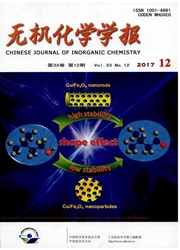

 中文摘要:
中文摘要:
采用两步加热高温固相法合成了掺杂Nd^3+的LiFe1-xNdxPO4/C复合材料(x=0,0.01,0.02,0.04,0.06,0.08)。用TG—DSC对前驱体进行分析和SQUID(超导量子干涉仪)对样品中Fe^3+的磁性测定。优化了合成工艺条件;采用XRD、FE-SEM、EDS等方法分析了样品的结构并对其电化学性能进行了测试。结果表明:LiFe1-xNdxPO4/C复合材料具有橄榄石型结构;当Nd^3+的掺杂量6%(物质的量分数1、煅烧温度700℃、煅烧时间16h时,样品在0.2C(1C=170.0mA·g^-1)电流密度下的最大放电比容量可达165.2mAh·g^-1,循环100次后的容量保持率仍为92.8%,在1C、2C、5C下的最大放电比容量分别为146.8、125.7和114.8mAh·g^-1。通过测定样品在不同较低倍率下的放电比容量,采用外推法得出制备样品的实测理论比容量为168.7mAh·g^-1。
 英文摘要:
英文摘要:
LiFe1-xNdxPO4(x=0, 0.01, 0.02, 0.04, 0.06, 0.08) cathode material for Li-ion battery was synthesized by two-step heating solid-state reaction. The synthesis conditions were optimized through the thermal analysis of the precursor by TG-DSC and the magnetic measurement of Fe^3+in LiFe1-xNdxPO4/C sample by SQUID(Superconducting QUantum Interference Device). The structure and electrochemical performance of the material were studied by XRD, FE-SEM, EDS and galvanostatic charge-discharge method. The results show that LiFe1-xNdxPO4/C sample has the same olivine structure as LiFePO4 When the dopant of Nd^3+ is 6%(molar fraction) and precursor is calcined for 16 h at 700 ℃, the sample delivers the highest discharge capacity of 165.2 mAh .g^-1 at 0.2C (1C=170.0 mA·g^-1) rate, and the capacity retention rate is 92.8% after 100 cycles, and 146.8 mAh .g^-1, 125.7 mAh.g^-1, 114.8 mAh·g^-1 at 1, 2, 5 C-rates, respectively. The measured theoretical capacity is about 168.7 mAh·g^-1 by measuring the capacity at various discharge current density and extrapolating to the current density of zero.
 同期刊论文项目
同期刊论文项目
 同项目期刊论文
同项目期刊论文
 A new kind of mesoporous Fe7Co3/carbon nanocomposite and its application as magnetically separable a
A new kind of mesoporous Fe7Co3/carbon nanocomposite and its application as magnetically separable a Facile Synthesis of Porous Fe7Co3/Carbon Nanocomposites and Their Applications as Magnetically Separ
Facile Synthesis of Porous Fe7Co3/Carbon Nanocomposites and Their Applications as Magnetically Separ Synthesis, structures and magnetic properties of n=3 Ruddlesden-Popper compounds Ca4Mn3-xTaxO10 (0 &
Synthesis, structures and magnetic properties of n=3 Ruddlesden-Popper compounds Ca4Mn3-xTaxO10 (0 & Magnetic structure and orbital ordering in tetragonal and monoclinic KCrF3 from first-principles cal
Magnetic structure and orbital ordering in tetragonal and monoclinic KCrF3 from first-principles cal 期刊信息
期刊信息
